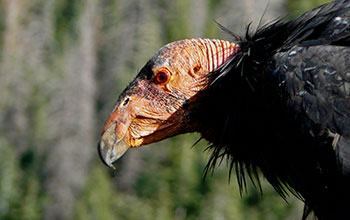Multimedia Gallery
An adult, critically endangered California condor
An adult, critically endangered California condor that was released into the wild in the Grand Canyon region of Arizona.
More about this image
Vultures in some parts of the world are in danger of disappearing, which, according to a recent report by researchers at the University of Utah, would have serious consequences for ecosystems and human populations alike.
According to the report, by Evan R. Buechley and Çağan Şekercioğlu of Utah's Department of Biology, the primary threat to vultures is the presence of toxins in the carrion they consume. In many parts of the world, vultures feast on poisoned carcasses. Since dozens or even hundreds of vultures may feast on a single poisoned carcass, the losses can be staggering. As a result, populations of most vulture species around the world are now either declining or on the brink of extinction. The result is a proliferation of scavengers that can bring bacteria and viruses from carcasses into human cities.
Buechley and Şekercioğlu examined factors affecting the extinction risk of more than 100 bird species, including 22 species of vultures, which eat carrion exclusively, and other scavenging birds that have broader diets. Their results suggest several inherent ecological traits that likely contribute to vultures’ extinction risks, including their large body mass, slow reproductive rates and highly specialized diets. The greatest external threat to vultures, however, is poisoning, which impacts 88 percent of threatened vulture species.
The poisons come in many forms. For example, the leading cause of the California condor decline a few decades ago was lead bullet fragments in the gut piles left behind by hunters after animals had been field-dressed. Once discovered as the cause, intensive conservation efforts helped the species rebound and they now number over 400 (up from just 22 in 1982).
In the mid-1990s, a swift decline of vultures in India was found to be caused by diclofenac, a veterinary anti-inflammatory drug that relieved pain in cattle but was found to be highly toxic to vultures. Hundreds of vultures would flock to a single cattle carcass and if the cow had recently been treated with diclofenac, hundreds of vultures would die, leading to a steep vulture decline. International cooperation led to a total ban on veterinary diclofenac use and, Buechley says, the numbers of vultures have stabilized and are now showing signs of slowly increasing.
The current focus of vulture decline is in sub-Saharan Africa, where potent, newly affordable poisons are used to control predatory pests like lions or jackals. These highly toxic poisons can cascade through ecosystems, killing birds, mammals and insects, but vultures take the brunt of the poisoning and face the largest number of casualties. In 2007 in Namibia, a poisoned elephant carcass killed as many as 600 vultures that were feeding off it. Vultures are also being killed by poachers, who poison carcasses so the birds don't give away the location of illegally taken animals.
With the absence of vultures, other scavenger populations increase to take advantage of uneaten carrion. Some estimates show that vultures eat more meat than all predators combined in Central America, South America and Africa. Without vultures, animals that eat carrion as part of their diet--called facultative scavengers, as opposed to vultures, which eat only carrion--multiply to take advantage of the available nutrients in a dead carcass. This means that crows, rats and dogs, any of these species can suddenly become abundant and dominant to the point of crowding out the remaining vultures.
Changes in populations of certain animal groups can upset the balance of food webs. "All these facultative scavengers are also predators, and so they also go out and eat other organisms too," Buechley says. "You have this cascading effect."
A decline of vultures can have other affects beyond ecological. Vultures serve as a barrier to prevent diseases from proliferating in dead animals and spreading to humans, whom they rarely come in contact with. Vultures are capable of locating and consuming a carcass within an hour, before other forms of decay can set in. And their highly acidic stomachs kill nearly all bacteria or viruses that may be present in carrion. Other facultative scavengers are not so adapted, and could pass along those diseases into human populations, as many are already fixtures in cities.
The study was funded by a National Science Foundation Graduate Research Fellowship (grant DGE 1256065) and by the University of Utah’s Global Change and Sustainability Center.
To learn more, see the Utah news story Why Vultures Matter and What We Lose If they're Gone. (Date image taken: 2015; date originally posted to NSF Multimedia Gallery: Aug. 29, 2016)
Credit: Evan R. Buechley, University of Utah
See other images like this on your iPhone or iPad download NSF Science Zone on the Apple App Store.
Images and other media in the National Science Foundation Multimedia Gallery are available for use in print and electronic material by NSF employees, members of the media, university staff, teachers and the general public. All media in the gallery are intended for personal, educational and nonprofit/non-commercial use only.
Images credited to the National Science Foundation, a federal agency, are in the public domain. The images were created by employees of the United States Government as part of their official duties or prepared by contractors as "works for hire" for NSF. You may freely use NSF-credited images and, at your discretion, credit NSF with a "Courtesy: National Science Foundation" notation.
Additional information about general usage can be found in Conditions.
Also Available:
Download the high-resolution JPG version of the image. (3.5 MB)
Use your mouse to right-click (Mac users may need to Ctrl-click) the link above and choose the option that will save the file or target to your computer.



 All images in this series
All images in this series